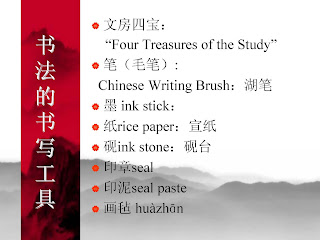Labels
- China Trip (5)
- culture lecture (3)
- Holloween (2)
- Huanying Review (3)
- humor (1)
- Sing a song (1)
- success (1)
- video (2)
Tuesday, November 30, 2010
Sunday, November 21, 2010
Wednesday, November 17, 2010
Tuesday, November 16, 2010
Let's go to visit Virtual Forbidden City
Dear students and parents, if you do not have a chance to visit Beijing, at least you can go to this one.
Introduction of Forbidden City (zi jin cheng---Chinese pronunciation)
Introduction
The coming February, during our x-term, 8 students and I will go to China! Our first destination will be Forbidden City! I am sure you have heard so much about it. Now let's take time to know more details about this Forbidden City.
One million workers toiled on the palaces of the Ming Dynastities and and Qing Dynasties (1421 to 1924). The Forbidden City wall that encompasses its 9,999 rooms (hi kids, do you still remember why it is 9,999 rooms? Any special meaning?
Yes, 9 in Chinese pronunciation also means "long". All the emperors want to live forever!! Of course that is impossible.
Forbidden City also consists of 12 million bricks. Another 20 million bricks ended up in the walls of the pavilions and the surfaces of courtyards. The best way to navigate and make some sense of this vast collection of passageways, pavilions is to rent a tape machine as your guide at the entrance. This tape identifies major halls, walls, thrones, furniture, and costumes in the palace.
Here this introduction is from www.baidu.com, if you have time, read it.
"Lying at the center of Beijing, the Forbidden City, also called Gu Gong, in Chinese, was the imperial palace during the Ming and Qing dynasties. Now known as the Palace Museum, it is to the north of Tiananmen Square. Rectangular in shape, it is the world‘s largest palace complex and covers 74 hectares. Surrounded by a six meter deep moat and a ten meter high wall are 9,999 buildings. The wall has a gate on each side. Opposite the Tiananmen Gate, to the north is the Gate of Devine Might (Shenwumen), which faces Jingshan Park. The distance between these two gates is 960 meters, while the distance between the gates in the east and west walls is 750 meters. There are unique and delicately structured towers on each of the four corners of the curtain wall. These afford views over both the palace and the city outside. The Forbidden City is divided into two parts. The southern section, or the Outer Court was where the emperor exercised his supreme power over the nation. The northern section, or the Inner Court was where he lived with his royal family.
Until 1924 when the last emperor of China was driven from the Inner Court, fourteen emperors of the Ming dynasty and ten emperors of the Qing dynasty had reigned here. Having been the imperial palace for some five centuries, it houses numerous rare treasures and curiosities. Listed by UNESCO as a World Cultural Heritage Site in 1987, the Palace Museum is now one of the most popular tourist attractions world wide. Construction of the palace complex began in 1407, the 5th year of the Yongle reign of the third emperor of the Ming dynasty. It was completed fourteen years later in 1420. It was said that a million workers including one hundred thousand artisans were driven into the long-term hard labor. Stone needed was quarried from Fangshan, a suburb of Beijing. It was said a well was dug every fifty meters along the road in order to pour water onto the road in winter to slide huge stones on ice into the city. Huge amounts of timber and other materials were freighted from faraway provinces. Ancient Chinese people displayed their very considerable skills in building the Forbidden City. Take the grand red city wall for example.,it has an 8.6 meters wide base reducing to 6.66 meters wide at the top. The angular shape of the wall totally frustrates attempts to climb it. The bricks were made from white lime and glutinous rice while the cement is made from glutinous rice and egg whites. These incredible materials make the wall extraordinarily strong. Since yellow is the symbol of the royal family, it is the dominant color in the Forbidden City. Roofs are built with yellow glazed tiles; decorations in the palace are painted yellow; even the bricks on the ground are made yellow by a special process. However, there is one exception. Wenyuange, the royal library, has a black roof. The reason is that it was believed black represented water then and could extinguish fire. Nowadays, the Forbidden City, or the Palace Museum is open to tourists from home and abroad. Splendid painted decoration on these royal architectural wonders, the grand and deluxe halls, with their surprisingly magnificent treasures will certainly satisfy "modern civilians"."
Doors in Forbidden City:
One corner of this mysterious city:
In the morning:
Lions, represent the power:
River:
Bridges:
See this picture? What is this? How many are there altogether?
Enjoy!
Monday, November 15, 2010
Ni Hao! Da Jia Hao!
Ni Hao! Wo shi Zhu laoshi.
I have been thinking about creating a blog for my students for a long time. Here students can post their favorite website and pictures, exchange ideas, practice, and have fun!
I love my students. They are sooooo cute and talented.
Saying these, let's have a cup of tea and get started!
I have been thinking about creating a blog for my students for a long time. Here students can post their favorite website and pictures, exchange ideas, practice, and have fun!
I love my students. They are sooooo cute and talented.
Saying these, let's have a cup of tea and get started!
Subscribe to:
Posts (Atom)










































